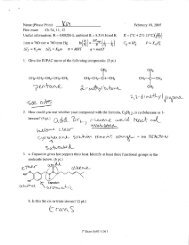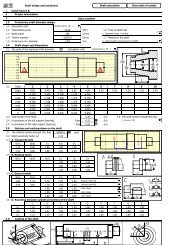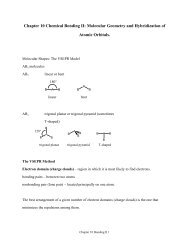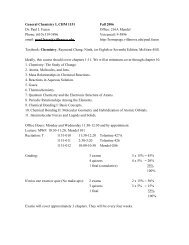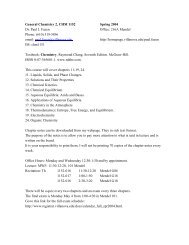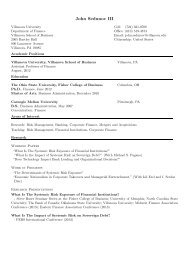Chapter 4 - Reactions in Aqueous Solution
Chapter 4 - Reactions in Aqueous Solution
Chapter 4 - Reactions in Aqueous Solution
Create successful ePaper yourself
Turn your PDF publications into a flip-book with our unique Google optimized e-Paper software.
Triprotic acids - yield three H+ ionsH 3PO 4( aq)→ H + ( aq ) + H 2 PO 4 − ( aq)−H 2 PO 4 ( aq ) → H+( aq) + HPO 4 2− ( aq)2−HPO 4 ( aq)→ H+( aq) + PO 4 3− ( aq)net equationH 3 PO 4 ( aq)→ 3 H + ( aq ) + PO 4 3− ( aq )Bases are substances that accept (react with) H + ions.(Bronsted)H + ( aq) + OH − ( aq) → H 2 O ( l)NH 3 ( aq) + H +2O ( l)→ NH 4 ( aq)+ OH − ( aq)Bases <strong>in</strong>crease the concentration of OH – (aq) ions <strong>in</strong> water. (Arrhenius def<strong>in</strong>ition)Strong and Weak Acids and BasesAcids and bases that are strong electrolytes are called strong acids and strong bases.Those that are weak electrolytes are weak acids and weak bases.Molecular Formula Acid Name Anion Name of AnionHCl, Hydrogen chloride Hydrochloric acid Cl – ChlorideHBr, Hydrogen bromide Hydrobromic acid Br – BromideHI, Hydrogen Iodide Hydroiodic acid I – IodideHNO 3Nitric acid NO 3– NitrateHClO 4Perchloric acid ClO 4– PerchlorateHClO3 Chloric acid ClO3 – ChlorateH 2 SO 4Sulfuric acid SO 42– SulfateCh 4 <strong>Reactions</strong> <strong>in</strong> <strong>Aqueous</strong> <strong>Solution</strong> - 6 -



